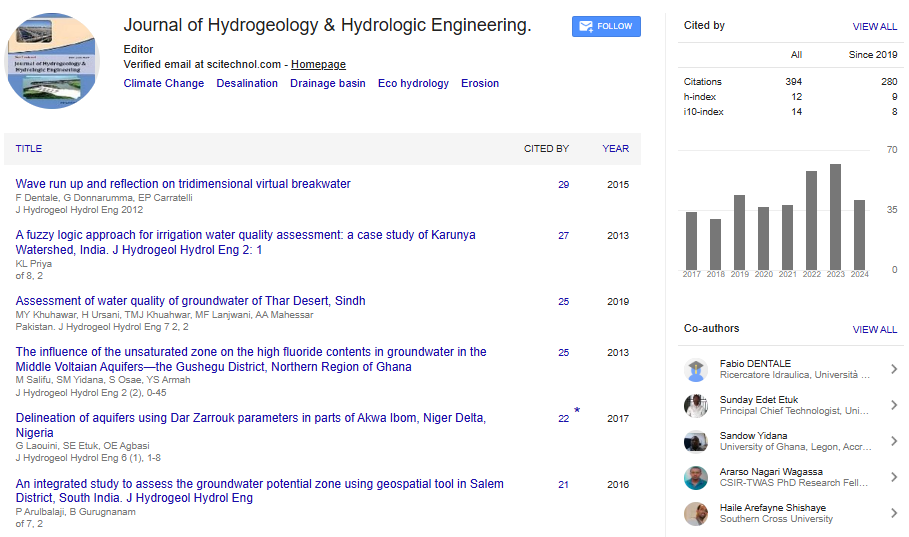Perspective, J Hydrogeol Hydrol Eng Vol: 13 Issue: 6
The Role of Desalinization in Combating Universal Water Depletion
Anika Sharma*
1Department of Civil Engineering, Cairo University, Cairo, Egypt
*Corresponding Author: Anika Sharma,
Department of Civil Engineering, Cairo
University, Cairo, Egypt
E-mail: sharma48@gmail.com
Received date: 26 November, 2024, Manuscript No. JHHE-24-154123;
Editor assigned date: 28 November, 2024, PreQC No. JHHE-24-154123 (PQ);
Reviewed date: 12 December, 2024, QC No. JHHE-24-154123;
Revised date: 20 December, 2024, Manuscript No. JHHE-24-154123 (R);
Published date: 27 December, 2024, DOI: 10.4172/2325-9647.1000353.
Citation: Sharma A (2024) The Role of Desalinization in Combating Universal Water Depletion. J Hydrogeol Hydrol Eng 13:6.
Description
Water scarcity is a growing challenge worldwide, driven by population growth, urbanization and climate change. Desalination, the process of removing salts and impurities from seawater or brackish water, has emerged as an essential technology in addressing this issue. By providing access to freshwater in arid regions and coastal areas, desalination offers a sustainable solution for meeting increasing water demands.
Desalination involves converting saline water into freshwater through two primary methods: Thermal desalination and membranebased desalination. Thermal desalination uses heat to evaporate water, leaving salts behind, followed by condensation to produce freshwater. This method is energy-intensive but effective in regions where energy resources are abundant.
Membrane-based desalination, particularly Reverse Osmosis (RO), has become the dominant technology. RO forces water through semipermeable membranes that filter out salts and impurities. This approach is more energy-efficient than thermal methods and is widely implemented in modern desalination plants.
Applications of desalination
Desalination has diverse applications across various sectors:
Municipal water supply: Many cities in water-scarce regions, such as the Middle East and North Africa, rely on desalination plants for drinking water. Countries like Saudi Arabia and the United Arab Emirates have invested heavily in desalination infrastructure to ensure a reliable water supply.
Agriculture: Irrigation accounts for a significant portion of global water usage. In regions with limited freshwater resources, desalination can provide water for agriculture, helping to sustain food production.
Industrial use: Industries, especially those in coastal regions, require significant amounts of freshwater for cooling, cleaning and production processes. Desalination plants help meet these demands without depleting natural freshwater reserves.
Emergency Situations: During natural disasters or in areas with contaminated water sources, portable desalination units can provide clean drinking water to affected populations.
Challenges and advancements
While desalination offers a promising solution to water scarcity, it also faces several challenges.
Energy consumption: Desalination is energy-intensive, particularly for large-scale plants. The reliance on fossil fuels for energy can lead to high operational costs and environmental impacts, including greenhouse gas emissions.
Environmental concerns: The discharge of brine, a highly concentrated salt solution, into the ocean can harm marine ecosystems. Researchers are discovering ways to manage and repurpose brine to mitigate its environmental impact.
Affordability: High capital and operational costs make desalination less accessible for developing countries. However, advances in technology, such as energy recovery systems and improved membrane efficiency, are driving costs down.
Water quality: While desalination effectively removes salts and impurities, it can strip water of beneficial minerals. Post-treatment processes are necessary to re-mineralize the water to meet health standards.
The future of desalination lies in innovation and sustainability. The integration of renewable energy sources, such as solar and wind, into desalination processes is a major focus area. Solar-powered desalination plants are particularly promising for off-grid regions with abundant sunlight.
Advancements in nanotechnology and materials science are also improving membrane performance, reducing energy consumption and extending the lifespan of desalination systems. Additionally, hybrid systems combining desalination with wastewater recycling and rainwater harvesting are being discovered to create more strong water supply networks.
Conclusion
Desalination has become a precarious tool in addressing the global water crisis. By playing advancements in technology and adopting sustainable practices, the desalination industry can expand its reach while minimizing environmental and economic challenges. As the demand for freshwater continues to grow, desalination will play an increasingly vital role in securing water resources for future generations.
 Spanish
Spanish  Chinese
Chinese  Russian
Russian  German
German  French
French  Japanese
Japanese  Portuguese
Portuguese  Hindi
Hindi 
